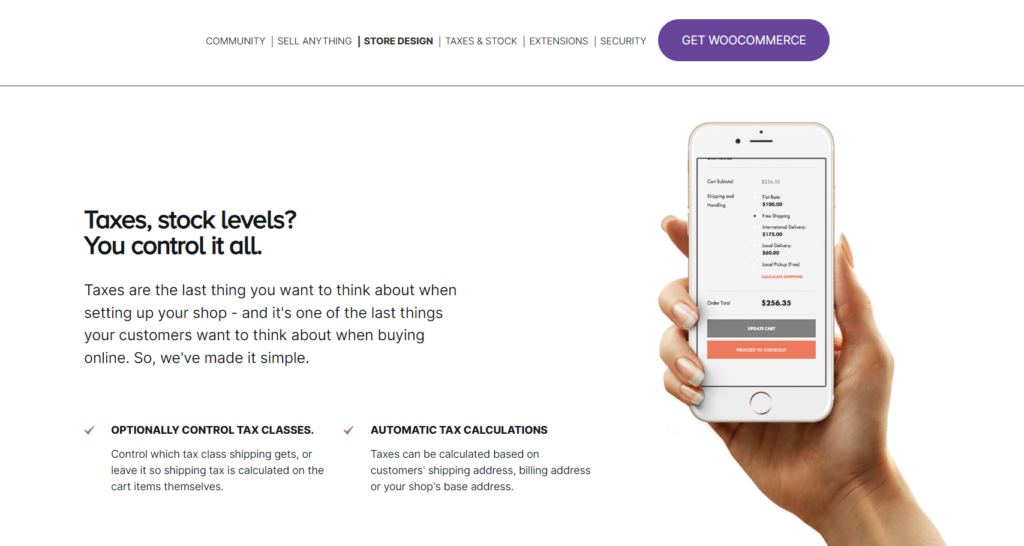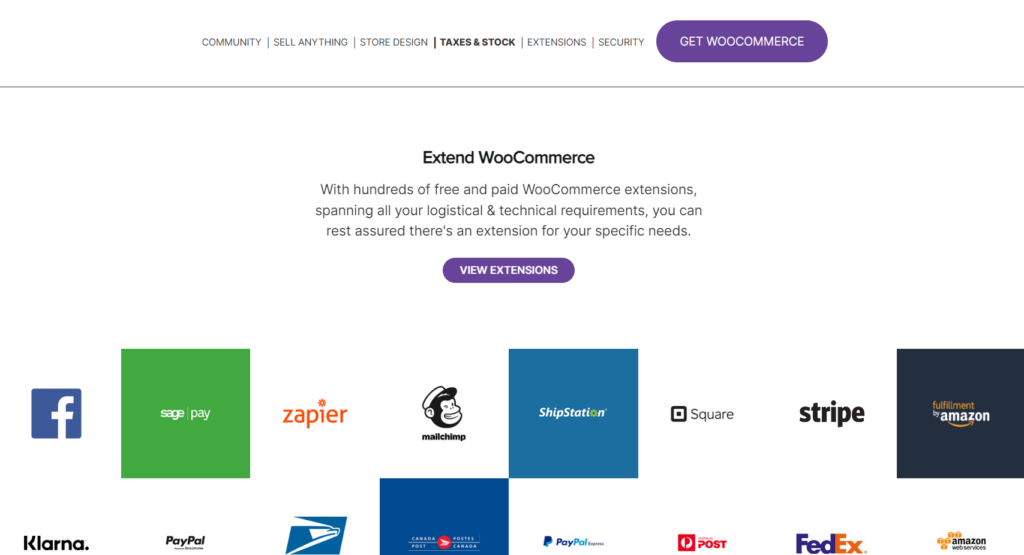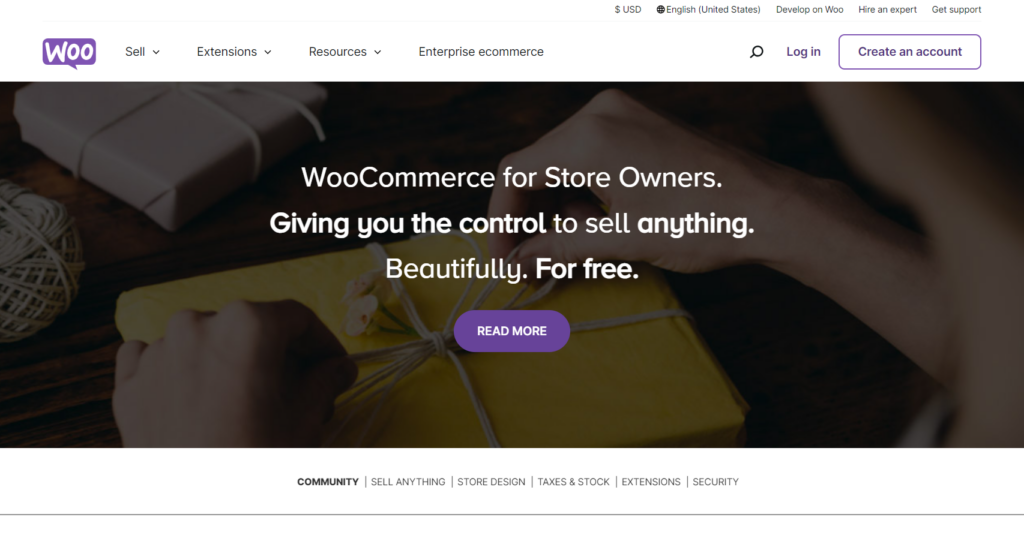Table of Contents
WooCommerce offers a flexible and scalable solution for businesses aiming to establish a strong online presence. As a powerful plugin for WordPress, it provides a user-friendly interface and extensive customization options, allowing users to build and manage their online store with ease. WooCommerce supports a wide range of features, including product management, payment gateways, and shipping options, making it a versatile choice for eCommerce.
Its pricing structure is competitive, with a free core plugin and various paid extensions available to enhance functionality. However, users should be aware that while WooCommerce itself is free, costs can accumulate with premium extensions and hosting requirements. If your business values customization and is comfortable managing a WordPress site, WooCommerce offers a cost-effective and robust platform to grow your online store.
Let’s Cut to the Chase!
Consider WooCommerce Online Store If:
- You seek a highly customizable eCommerce solution integrated with WordPress, offering a wide range of features and extensions to tailor your online store to your specific needs.
- You need a platform that supports various payment gateways, shipping options, and product types, providing a comprehensive toolkit for a successful online store.
- You want a cost-effective platform with a free core plugin, allowing you to control expenses by only paying for the extensions and features you require.
- You are comfortable managing a WordPress site and are looking for a scalable solution that grows with your business, providing flexibility to adapt to changing demands.
Do Not Choose WooCommerce If:
- You prefer a turnkey eCommerce solution with minimal setup and maintenance, as WooCommerce requires a solid understanding of WordPress and regular updates.
- You have a tight budget for initial setup, as while WooCommerce itself is free, the cost of premium extensions, themes, and hosting can add up, especially for larger or more complex stores.
- You prefer a more predictable pricing model, as WooCommerce’s costs can be variable based on the extensions and hosting services you choose.
- You need a highly integrated platform with built-in features for advanced marketing automation and predictive analytics, as WooCommerce’s core functionality is basic and relies on additional plugins for extended capabilities.
- You seek a fully managed eCommerce solution with customer support included, since WooCommerce is a self-hosted platform where you’ll need to handle hosting, security, and support independently.
THE BOTTOM LINE
🌐 WooCommerce presents a versatile and cost-effective solution for businesses seeking to build and manage an online store within the WordPress ecosystem. Its flexibility and extensive range of plugins and themes allow for significant customization, making it suitable for various eCommerce needs. The platform’s core plugin is free, and additional features can be added as required, which helps control costs.
However, WooCommerce demands a degree of technical expertise and ongoing management, which might be a hurdle for those unfamiliar with WordPress. If you’re comfortable with WordPress and require a highly adaptable eCommerce platform, WooCommerce is a worthy investment that offers great value and scalability. For businesses seeking an out-of-the-box solution with minimal setup and support needs, other eCommerce platforms might be more suitable.
Now, Let’s Detail Things for You

When it comes to pricing, WooCommerce is quite deceptive—it seems free at first glance, but the costs quickly pile up. Sure, the WooCommerce plugin itself doesn’t cost anything, but you’ll need to budget for a few other essentials. Domain registration alone will set you back between $8 and $20 per year, while hosting services can range from $80 to $300 annually, depending on the provider and your needs. Add to this the cost of a WooCommerce theme, which can vary from $0 to $120, and payment gateway fees that typically charge around 2.9% plus 30 cents per transaction, along with a potential monthly fee of up to $30.
On top of that, third-party integrations and extensions can run anywhere from $0 to over $300 per year, and if you require a WooCommerce developer for customizations, expect to pay $10 to $100+ per hour. With all these factors combined, the total cost of operating a WooCommerce store can be substantial, far exceeding the initial impression of a “free” plugin.
What’s the Catch with WooCommerce Online Store?
At first glance, WooCommerce might seem like a budget-friendly solution for setting up an online store, but there are hidden costs that can catch you off guard. The plugin itself is free, but that’s just the beginning. You’ll need to factor in domain registration and hosting fees, which aren’t included in the base price. Additionally, while many WooCommerce themes come with a one-time fee, others can carry ongoing costs. Payment gateways add another layer of expenses, with transaction fees and potential monthly charges.
Plus, if you need third-party extensions or custom development work, the costs can quickly escalate. Unlike some services that offer clear-cut pricing, WooCommerce’s total cost can be obscured by these additional expenses. It’s essential to calculate all these factors before committing to avoid unexpected surprises.
What You Need to Know

What you need to know about WooCommerce pricing is that it extends beyond the initial appeal of a free plugin. While WooCommerce itself doesn’t cost anything to download, creating a fully functional online store involves several additional expenses. First, you’ll need to invest in domain registration and web hosting, which typically range from $8 to $20 per year for the domain and $80 to $300 per year for hosting, depending on your needs.
Themes for WooCommerce can vary widely, with prices ranging from free to about $120. Payment gateway fees are another consideration, usually involving a standard rate of 2.9% plus 30 cents per transaction, along with possible monthly fees of $0 to $30. Additionally, integrating third-party extensions can cost anywhere from $0 to several hundred dollars annually, depending on the functionalities you need. If custom development is required, expect to pay $10 to $100 per hour for professional services, which can add up significantly.
WooCommerce’s pricing structure is not always straightforward, as many costs are not immediately apparent and can accumulate as you add features and integrations. It’s crucial to thoroughly assess these potential costs before committing to ensure that WooCommerce fits within your budget and aligns with your business goals.
PRO TIPS >>> Best Ecommerce Platforms For Startups
What are WooCommerce Online Store Competitors Offering?
WooCommerce vs. Wix eCommerce
Wix eCommerce starts at $23/month, offering an easy setup with a drag-and-drop interface. Wix includes hosting and essential features like payment processing, making it user-friendly. WooCommerce provides greater flexibility and customization but requires more hands-on management of hosting and technical aspects.
WooCommerce vs. Magento
Magento offers high customization and scalability, with a free open-source version and a paid Enterprise edition starting at $22,000/year. While Magento is complex and suited for large-scale operations, WooCommerce is more accessible for small to medium-sized businesses.
WooCommerce vs. Squarespace
Squarespace’s e-commerce plans start at $23/month, providing an integrated solution with hosting and design tools. It’s known for elegant templates and ease of use but offers less robust e-commerce features compared to WooCommerce, which excels with plugins but requires more setup effort.
WooCommerce vs. Shopify
WooCommerce is a free WordPress plugin, while Shopify operates on a subscription model starting at $39/month, covering hosting, security, and built-in e-commerce features. Shopify is more streamlined for users preferring an all-in-one solution. WooCommerce requires separate purchases for hosting and extensions, which can be cost-effective if you manage the technical setup.
WooCommerce vs. BigCommerce
BigCommerce starts at $39/month and offers a comprehensive platform with built-in tools for SEO, shipping, and analytics. Unlike WooCommerce, which relies on plugins for similar features, BigCommerce provides advanced e-commerce capabilities out-of-the-box, appealing to larger businesses. WooCommerce allows extensive customization but can incur additional costs.
What Affects WooCommerce Online Store Prices?

SEO and Marketing
Investing in SEO and marketing strategies impacts overall costs. Services for optimization, content creation, and marketing campaigns vary based on expertise and scope.
Platform and Features
While WooCommerce itself is free, costs accumulate with the selection of features and extensions. Premium plugins for advanced functionalities (e.g., shipping options, payment gateways, analytics) can significantly increase expenses.
Design and Customization
The design aspect plays a crucial role in pricing. Custom themes and tailored design work can be expensive. Although free themes are available, premium and custom designs typically come with higher costs due to their unique features.
Security and Compliance
Ensuring security and compliance with regulations is vital. This includes implementing SSL certificates and regular security audits, which can add to the investment required for a successful store.
Scalability and Upgrades
As the business grows, scalability needs may arise, requiring upgrades in hosting, additional plugins, or redesigns. Future scalability should be considered when assessing initial costs.
Market Conditions
Market conditions, such as demand for eCommerce solutions and availability of skilled professionals, can influence pricing. Competitive factors within the industry may also affect overall cost considerations.
What Affects Prices in the Industry Overall?
Stock Market Trends
Stock market trends can influence the pricing of eCommerce services indirectly. Companies in the tech sector, including those providing WooCommerce-related services, may experience fluctuations in stock prices that affect their operational costs and pricing strategies. For example, a downturn in tech stocks might lead to reduced investments in development and support, impacting the cost of services offered.
Technological Advancements
Technological advancements can also affect WooCommerce online store prices. Innovations in web development, hosting solutions, and eCommerce functionalities can lead to new pricing structures. For instance, the introduction of advanced features or new integrations may justify higher costs, while improved technologies that enhance efficiency might result in cost savings that are passed on to customers.
Economic Conditions
The broader economic environment significantly impacts WooCommerce online store prices. During periods of economic growth, businesses may have higher budgets for setting up and maintaining online stores, potentially leading to increased demand for premium features and services. Conversely, economic downturns can lead to tighter budgets, causing a shift towards more cost-effective solutions or scaled-back implementations.
Market Competition
The level of competition within the WooCommerce industry can drive pricing strategies. A highly competitive market may lead to more aggressive pricing, with providers offering discounts or bundled services to attract customers. Conversely, in a less competitive landscape, prices may remain higher as providers capitalize on their market position.
GET SMARTER >>> Shopify vs Magento
How to Get the Best Deal With WooCommerce Online Store?

Understand Your Needs Before Committing
Clearly define your business goals and necessary features. Determine if you need a basic setup or advanced functionalities like multi-channel selling or complex shipping options. This helps avoid unnecessary costs.
Compare Pricing Plans
Review the pricing structures of various WooCommerce hosting providers. Consider bandwidth, storage, support levels, and additional features. Starting with a basic plan and scaling as your store grows can be cost-effective.
Utilize Discounts and Promotions
Look for promotional offers from WooCommerce-related service providers. Many offer limited-time discounts or bundle deals. Subscribe to newsletters and follow social media for updates on these opportunities.
Evaluate Customer Support and Reliability
Choose a provider known for reliable customer support and strong uptime records. Effective support is crucial for addressing technical issues. Check reviews and testimonials for quality assessments.
Consider Open-Source Options
WooCommerce is a free, open-source plugin. While premium themes and plugins may incur costs, starting with the free version allows you to test functionality before investing.
Can You Afford WooCommerce Online Store Prices?
While some businesses might be willing to invest significantly in their WooCommerce online store, it’s essential to approach this decision with a clear understanding of your financial limits.
First, determine your budget. Knowing how much you’re willing to invest in your WooCommerce store will help narrow down your options. From basic hosting plans to premium themes and plugins, understanding your financial limits is crucial for making informed decisions.
Next, evaluate the significance of the features you need. How critical are advanced functionalities such as multi-channel integration, extensive customization, or high-performance hosting for your business operations? Prioritize the features that align with your business goals and branding strategy. This can help you avoid unnecessary expenses on tools that might not offer substantial benefits.
Finally, consider alternative solutions if your ideal setup proves too costly. There are often budget-friendly options that provide essential functionalities without the premium price tag. For instance, free or lower-cost themes and plugins can meet basic needs while still offering a professional appearance and functionality.
Finally: WooCommerce Online Store: Worth the Money and Trouble?
WooCommerce stands out as a robust and flexible solution for businesses looking to establish an online store. It offers extensive customization options, a wide range of plugins, and seamless integration with WordPress, making it a powerful tool for those who need a tailored eCommerce experience.
However, WooCommerce does come with its share of considerations. The platform requires a certain level of technical knowledge, and the costs can add up when factoring in hosting, premium themes, and essential plugins. For businesses with the resources to manage these aspects, WooCommerce can be a worthwhile investment, offering a scalable solution that grows with your business.
In summary, WooCommerce is worth the money and effort if you need a customizable online store and are ready to handle the associated costs and complexities. It may not be the simplest or cheapest option on the market, but its flexibility and power make it a strong contender for those serious about eCommerce.








